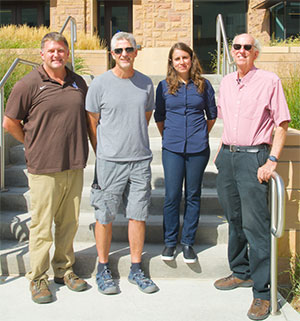UW Team Receives NSF Award to Study New Membrane Materials for Water Purification, Desalinization
Published September 15, 2021

The global disruption produced by climate change will place further stress on the world’s freshwater supplies due to higher temperatures, changing rainfall patterns and increases in human population, according to John Hoberg. This is expected to result in half of the world’s population facing freshwater shortages by 2030.
A research team at the University of Wyoming received a National Science Foundation (NSF) grant to investigate new membrane materials for purification and desalinization of water. The four-year research grant award, in the amount of nearly $1.77 million, is for a project titled “Salt Separation Membranes Based on Modifiable Two-Dimensional Covalent Organic Frameworks.” The grant begins Oct. 1 and continues through Sept. 30, 2025.
The research group is composed of Hoberg, a professor in UW’s Department of Chemistry; Bruce Parkinson, a UW School of Energy Resources professor of chemistry; Laura de Sousa Oliveira, a UW assistant professor of chemistry; Jonathan Brant, a professor in the UW Department of Civil and Architectural Engineering; and Zachary Gray, co-founder of WYONANO LLC, a company based in Sheridan.
“Since only about 3 percent of all water on Earth is suitable for human consumption and the oceans contain 97 percent of the Earth’s water, energy-efficient desalinization, or salt-separation technologies, is crucial for maintaining society’s quality of life,” Hoberg says. “Reverse osmosis is currently the most employed and reliable method for water desalinization. However, improvements in process efficiency are needed to make it a more sustainable treatment option.”
The improvements Hoberg mentions center on the physical and chemical characteristics of the membranes themselves to address issues related to salt selectivity, water permeability and chemical tolerance. The project’s researchers are working to produce new generations of membrane materials that are more stable, selective and energy efficient than current reverse osmosis membranes. These membrane materials can be modified for other water purification applications, such as the removal of specific contaminants.
“The new membrane materials will be based on two-dimensional, covalent organic frameworks -- 2D polymers with a defined but modifiable pore structure that can be synthesized with a high degree of order,” Hoberg explains. “Furthermore, the project researchers have developed synthetic strategies for putting a wide variety of functional groups in the pores. The 2D flake-like nature of the materials makes them naturally suited for semipermeable membrane applications.”
The project’s focus will be on putting charged functional groups in the pores and changing the pore sizes to make ion-selective membranes that reject either anions or cations with a specific size threshold initially focusing on desalinization. Anions are atoms with a negative charge, while cations are atoms that bear a positive electric charge.
To guide the synthesis of the new membrane materials and optimize their performance for a particular separation, the team will use a feedback loop between the organic synthesis of the membrane, membrane performance testing, and computational modeling and machine learning.
Hoberg says the research aligns with the goals of the NSF’s Designing Materials to Revolutionize and Engineer Our Future Materials Genome Initiative to accelerate materials discovery and development by building the fundamental knowledge base needed to advance the design and development of materials with desirable properties and functionality.
This research would likely not have gotten off the ground without initial seed funding of $200,000 provided by SER three years ago, Hoberg says. The seed funding led to the project receiving $3 million in grants from the U.S. Department of Energy, a Small Business Technology Transfer grant through WYONANO, and now NSF.

